engine Seat Cordoba 2008 Owner's Guide
[x] Cancel search | Manufacturer: SEAT, Model Year: 2008, Model line: Cordoba, Model: Seat Cordoba 2008Pages: 258, PDF Size: 7.87 MB
Page 114 of 258
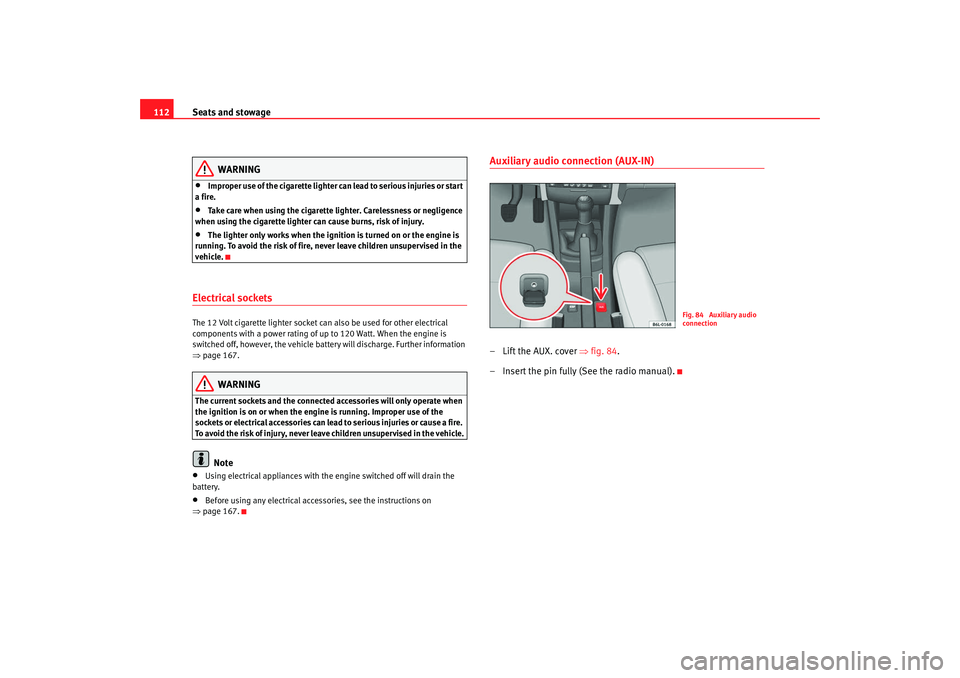
Seats and stowage
112
WARNING
•
Improper use of the cigarette lighter can lead to serious injuries or start
a fire.
•
Take care when using the cigarette lighter. Carelessness or negligence
when using the cigarette lighter can cause burns, risk of injury.
•
The lighter only works when the ignition is turned on or the engine is
running. To avoid the risk of fire, never leave children unsupervised in the
vehicle.
Electrical sockets The 12 Volt cigarette lighter socket can also be used for other electrical
components with a power rating of up to 120 Watt. When the engine is
switched off, however, the vehicle battery will discharge. Further information
⇒ page 167.
WARNING
The current sockets and the connected accessories will only operate when
the ignition is on or when the engine is running. Improper use of the
sockets or electrical accessories can lead to serious injuries or cause a fire.
To avoid the risk of injury, never leave children unsupervised in the vehicle.
Note
•
Using electrical appliances with the engine switched off will drain the
battery.
•
Before using any electrical accessories, see the instructions on
⇒ page 167.
Auxiliary audio connection (AUX-IN)– Lift the AUX. cover ⇒fig. 84 .
– Insert the pin fully (See the radio manual).
Fig. 84 Auxiliary audio
connection
COR_ING_0707 Seite 112 Mittwoch, 1. August 2007 6:25 18
Page 118 of 258
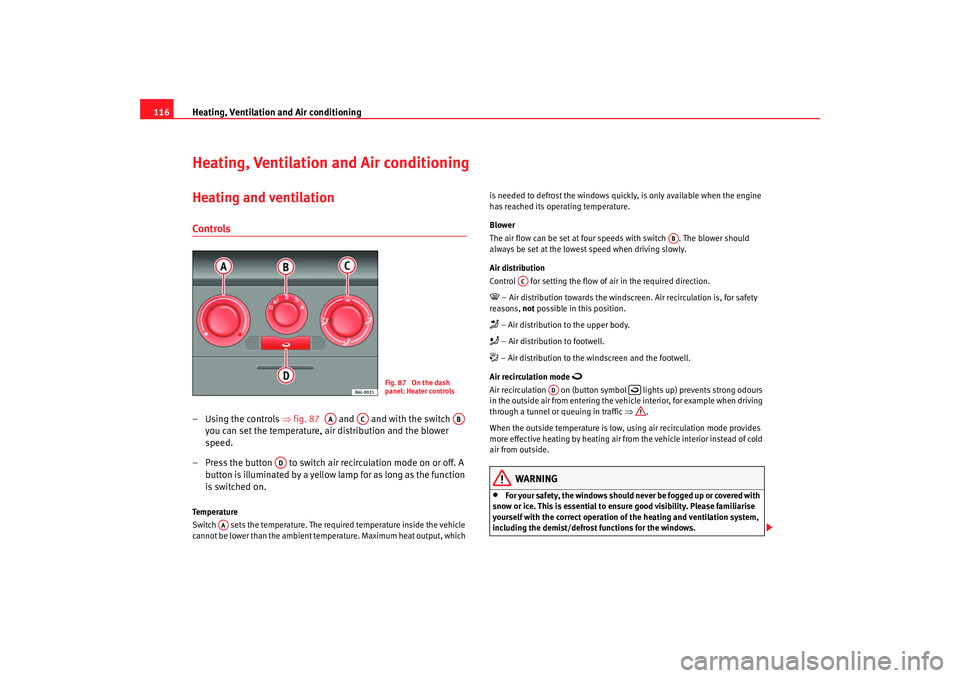
Heating, Ventilation and Air conditioning
116Heating, Ventilation and Air conditioningHeating and ventilationControls– Using the controls ⇒fig. 87 and and with the switch
you can set the temperature, air distribution and the blower
speed.
– Press the button to switch air recirculation mode on or off. A button is illuminated by a yellow lamp for as long as the function
is switched on.Temperature
Switch sets the temperature. The required temperature inside the vehicle
cannot be lower than the ambient temp erature. Maximum heat output, which is needed to defrost the windows quickly, is only available when the engine
has reached its operating temperature.
Blower
The air flow can be set at four speeds with switch . The blower should
always be set at the lowest speed when driving slowly.
Air distribution
Control for setting the flow of
air in the required direction.
– Air distribution towards the windsc reen. Air recirculation is, for safety
reasons, not possible in this position. – Air distribution to the upper body. – Air distribution to footwell. – Air distribution to the windscreen and the footwell.
Air recirculation mode
Air recirculation on (button symbol lights up) prevents strong odours
in the outside air from entering the vehicle interior, for example when driving
through a tunnel or queuing in traffic ⇒.
When the outside temperature is low, us ing air recirculation mode provides
more effective heating by heating air from the vehicle interior instead of cold
air from outside.
WARNING
•
For your safety, the windows should never be fogged up or covered with
snow or ice. This is essential to ensure good visibility. Please familiarise
yourself with the correct operation of the heating and ventilation system,
including the demist/defrost functions for the windows.
Fig. 87 On the dash
panel: Heater controls
AA
AC
AB
AD
AA
AB
AC
AD
COR_ING_0707 Seite 116 Mittwoch, 1. August 2007 6:25 18
Page 120 of 258
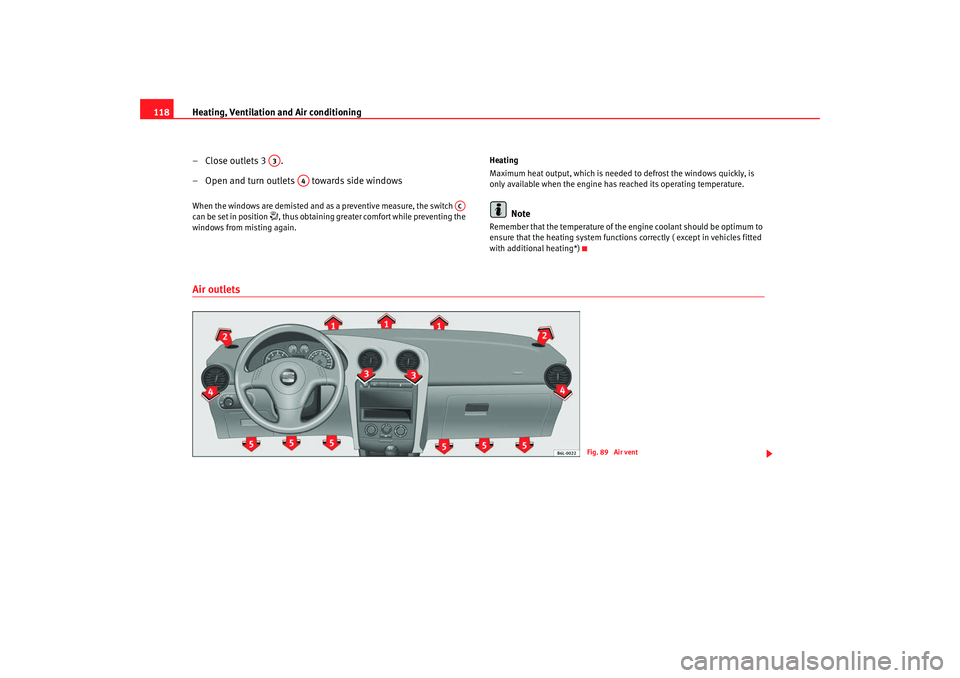
Heating, Ventilation and Air conditioning
118
– Close outlets 3 .
– Open and turn outlets towards side windowsWhen the windows are demisted and as a preventive measure, the switch
can be set in position
, thus obtaining greater comfort while preventing the
windows from misting again. Heating
Maximum heat output, which is needed to defrost the windows quickly, is
only available when the engine has reached its operating temperature.
Note
Remember that the temperature of the engine coolant should be optimum to
ensure that the heating system functions correctly ( except in vehicles fitted
with additional heating*)
Air outlets
A3
A4
AC
Fig. 89 Air vent
COR_ING_0707 Seite 118 Mittwoch, 1. August 2007 6:25 18
Page 121 of 258
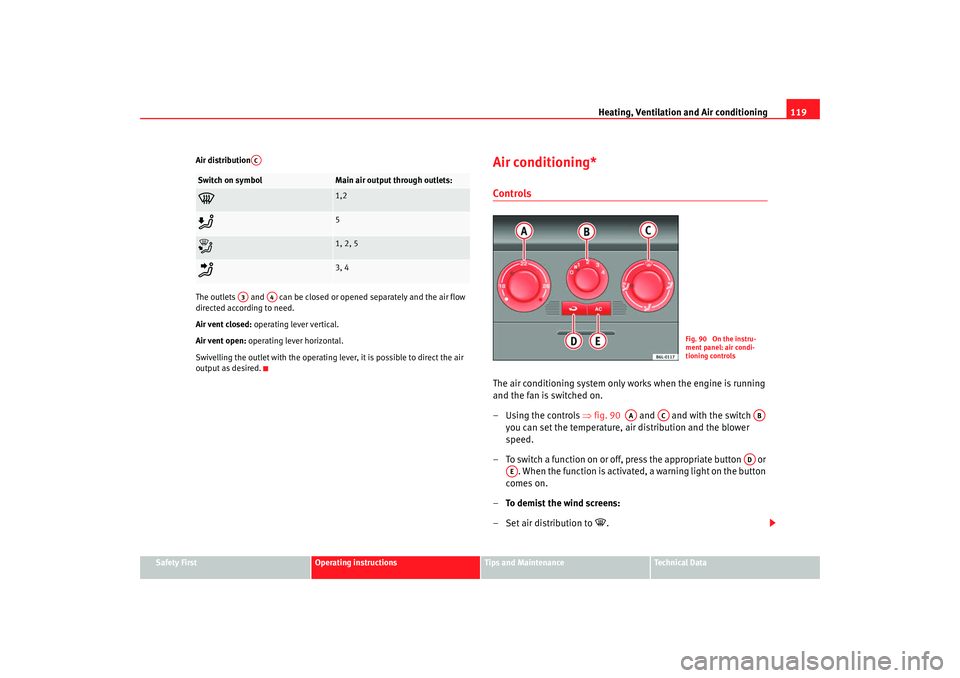
Heating, Ventilation and Air conditioning 119
Safety First
Operating instructions
Tips and Maintenance
Te c h n i c a l D a t a
Air distribution
The outlets and can be closed or opened separately and the air flow
directed according to need.
Air vent closed:
operating lever vertical.
Air vent open: operating lever horizontal.
Swivelling the outlet with the operating lever, it is possible to direct the air
output as desired.
Air conditioning* ControlsThe air conditioning system only works when the engine is running
and the fan is switched on.
– Using the controls ⇒fig. 90 and and with the switch
you can set the temperature, air distribution and the blower
speed.
– To switch a function on or off, press the appropriate button or . When the function is activated, a warning light on the button
comes on.
– To demist the wind screens:
– Set air distribution to
.
Switch on symbol
Main air output through outlets:
1,2
5
1, 2, 5
3, 4
AC
A3
A4
Fig. 90 On the instru-
ment panel: air condi-
tioning controls
AA
AC
AB
AD
AE
COR_ING_0707 Seite 119 Mittwoch, 1. August 2007 6:25 18
Page 123 of 258
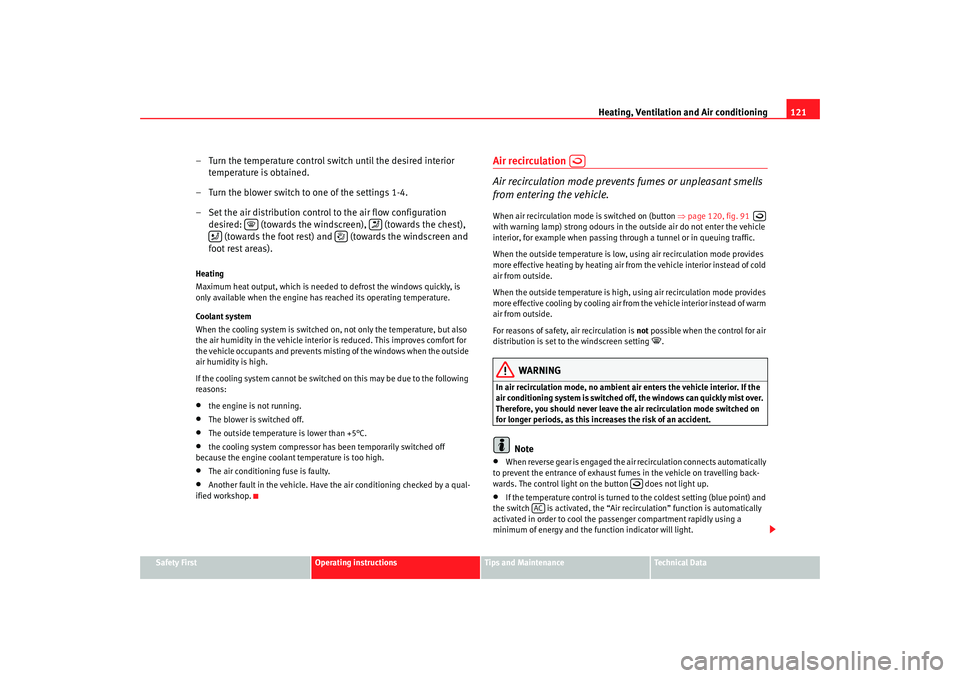
Heating, Ventilation and Air conditioning 121
Safety First
Operating instructions
Tips and Maintenance
Te c h n i c a l D a t a
– Turn the temperature control switch until the desired interior
temperature is obtained.
– Turn the blower switch to one of the settings 1-4.
– Set the air distribution control to the air flow configuration desired: (towards the windsc reen), (towards the chest),
(towards the foot rest) and (towards the windscreen and
foot rest areas).Heating
Maximum heat output, which is needed to defrost the windows quickly, is
only available when the engine has reached its operating temperature.
Coolant system
When the cooling system is switched on , not only the temperature, but also
the air humidity in the vehicle interior is reduced. This improves comfort for
the vehicle occupants and prevents misting of the windows when the outside
air humidity is high.
If the cooling system cannot be switched on this may be due to the following
reasons:•
the engine is not running.
•
The blower is switched off.
•
The outside temperature is lower than +5°C.
•
the cooling system compressor has been temporarily switched off
because the engine coolant temperature is too high.
•
The air conditioning fuse is faulty.
•
Another fault in the vehicle. Have the air conditioning checked by a qual-
ified workshop.
Air recirculation
Air recirculation mode prevents fumes or unpleasant smells
from entering the vehicle.When air recirculation mode is switched on (button ⇒page 120, fig. 91
with warning lamp) strong odours in th e outside air do not enter the vehicle
interior, for example when passing th rough a tunnel or in queuing traffic.
When the outside temperature is low, using air recirculation mode provides
more effective heating by heating air from the vehicle interior instead of cold
air from outside.
When the outside temperature is high, using air recirculation mode provides
more effective cooling by cooling air from the vehicle interior instead of warm
air from outside.
For reasons of safety, air recirculation is not possible when the control for air
distribution is set to the windscreen setting
.
WARNING
In air recirculation mode, no ambient air enters the vehicle interior. If the
air conditioning system is switched off, the windows can quickly mist over.
Therefore, you should never leave the air recirculation mode switched on
for longer periods, as this increases the risk of an accident.
Note
•
When reverse gear is engaged the air recirculation connects automatically
to prevent the entrance of exhaust fumes in the vehicle on travelling back-
wards. The control light on the button does not light up.
•
If the temperature control is turned to the coldest setting (blue point) and
the switch is activated, the “Air recirculation” function is automatically
activated in order to cool the passenger compartment rapidly using a
minimum of energy and the fu nction indicator will light.
AC
COR_ING_0707 Seite 121 Mittwoch, 1. August 2007 6:25 18
Page 124 of 258
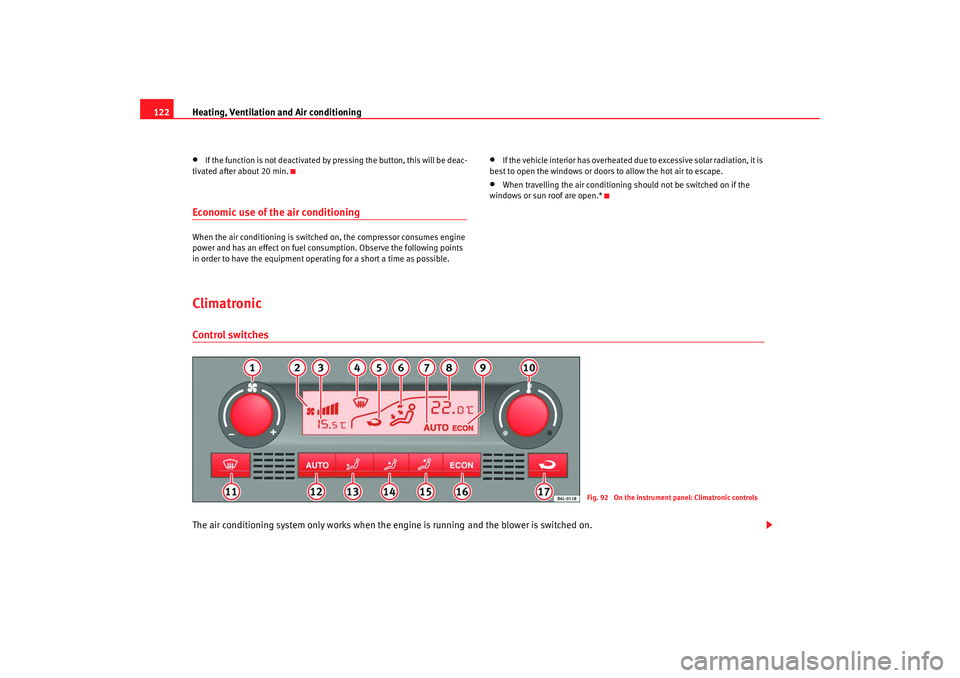
Heating, Ventilation and Air conditioning
122•
If the function is not deactivated by pressing the button, this will be deac-
tivated after about 20 min.
Economic use of the air conditioningWhen the air conditioning is switched on, the compressor consumes engine
power and has an effect on fuel co nsumption. Observe the following points
in order to have the equipment operating for a short a time as possible.
•
If the vehicle interior has overheated due to excessive solar radiation, it is
best to open the windows or doors to allow the hot air to escape.
•
When travelling the air conditioning should not be switched on if the
windows or sun roof are open.*
ClimatronicControl switchesThe air conditioning system only works when the engine i s ru
nning and the b l
ower is swit ched on.
Fig. 92 On the instrument panel: Climatronic controls
COR_ING_0707 Seite 122 Mittwoch, 1. August 2007 6:25 18
Page 128 of 258
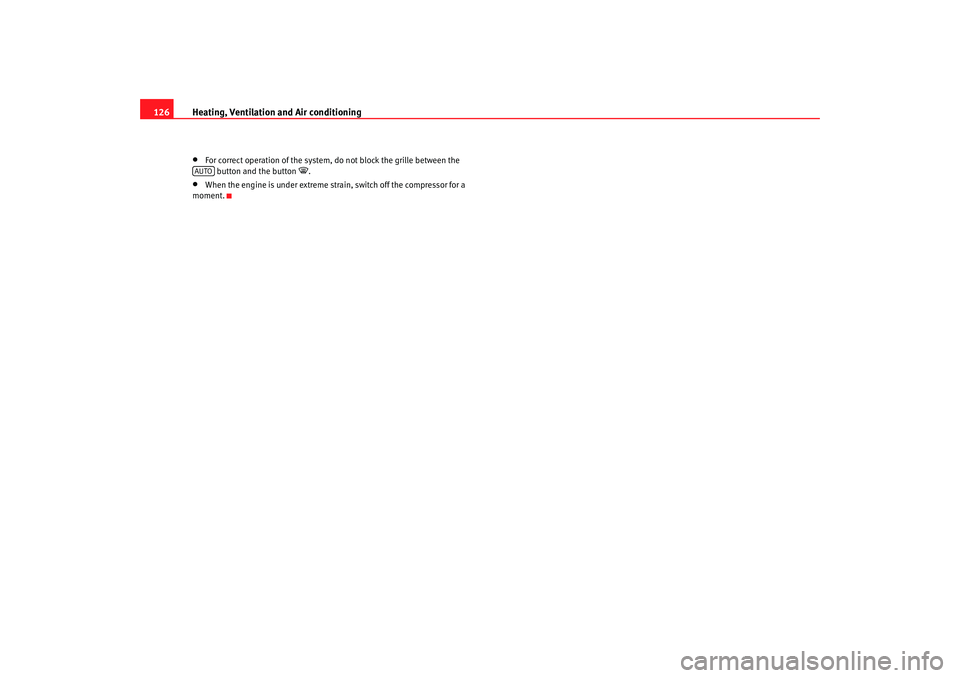
Heating, Ventilation and Air conditioning
126•
For correct operation of the system, do not block the grille between the
button and the button
.
•
When the engine is under extreme strain, switch off the compressor for a
moment.AUTO
COR_ING_0707 Seite 126 Mittwoch, 1. August 2007 6:25 18
Page 130 of 258
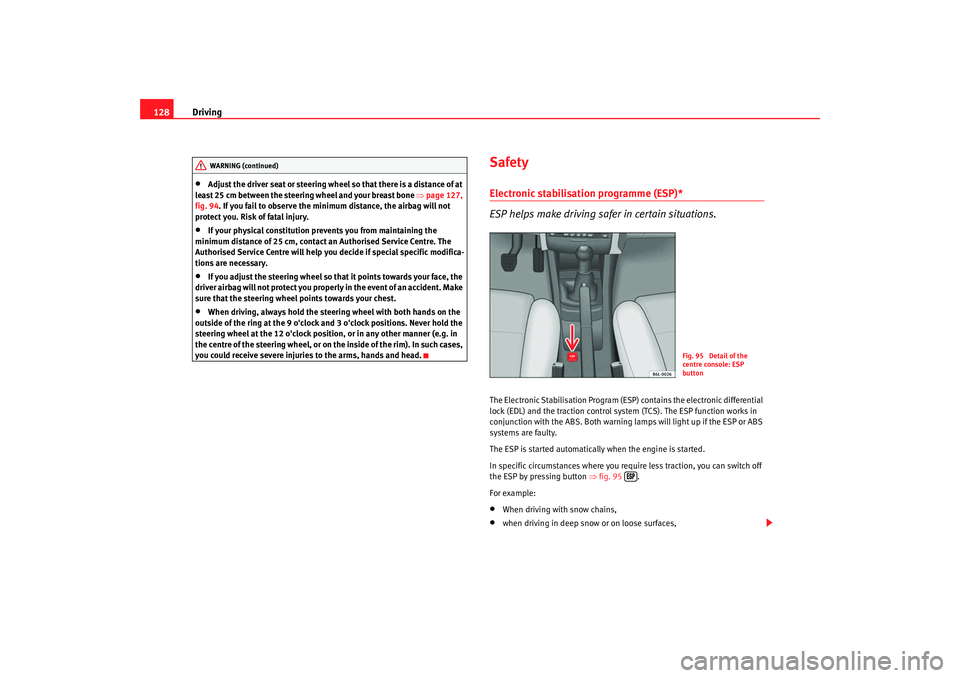
Driving
128•
Adjust the driver seat or steering wheel so that there is a distance of at
least 25 cm between the steering wheel and your breast bone ⇒page 127,
fig. 94. If you fail to observe the minimum distance, the airbag will not
protect you. Risk of fatal injury.
•
If your physical constitution prevents you from maintaining the
minimum distance of 25 cm, contact an Authorised Service Centre. The
Authorised Service Centre will help you decide if special specific modifica-
tions are necessary.
•
If you adjust the steering wheel so tha t it points towards your face, the
driver airbag will not protect you properly in the event of an accident. Make
sure that the steering wheel points towards your chest.
•
When driving, always hold the steer ing wheel with both hands on the
outside of the ring at the 9 o'clock and 3 o'clock positions. Never hold the
steering wheel at the 12 o'clock positi on, or in any other manner (e.g. in
the centre of the steering wheel, or on the inside of the rim). In such cases,
you could receive severe injuries to the arms, hands and head.
SafetyElectronic stabilisation programme (ESP)*
ESP helps make driving safer in certain situations.The Electronic Stabilisation Program (ESP ) contains the electronic differential
lock (EDL) and the traction control syst em (TCS). The ESP function works in
conjunction with the ABS. Both warning lamps will light up if the ESP or ABS
systems are faulty.
The ESP is started automatically when the engine is started.
In specific circumstances where you require less traction, you can switch off
the ESP by pressing button ⇒fig. 95 .
For example:•
When driving with snow chains,
•
when driving in deep snow or on loose surfaces,
WARNING (continued)
Fig. 95 Detail of the
centre console: ESP
button
COR_ING_0707 Seite 128 Mittwoch, 1. August 2007 6:25 18
Page 131 of 258
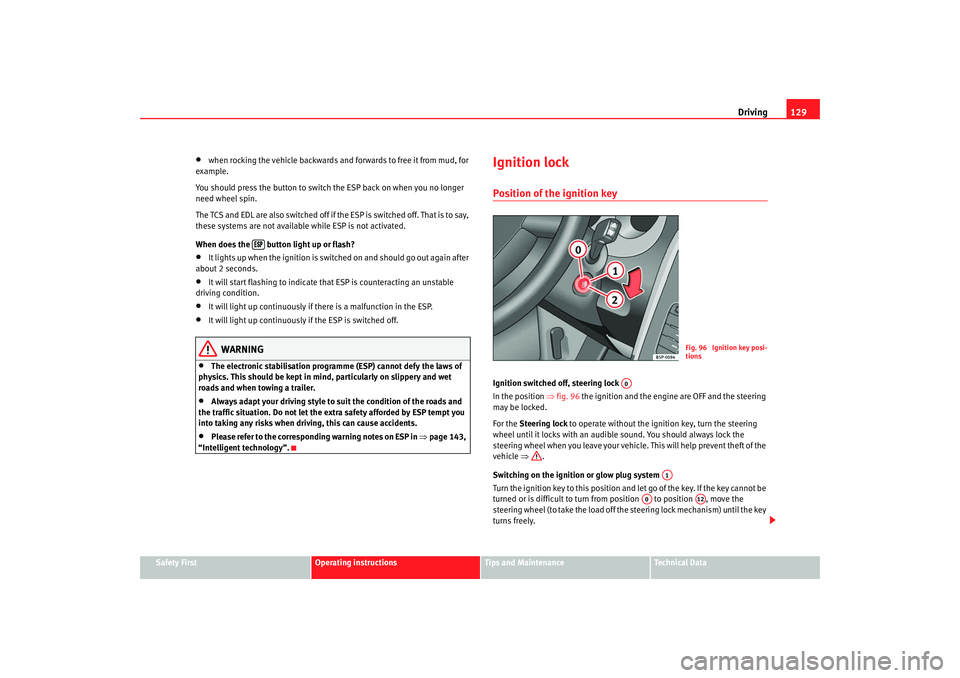
Driving129
Safety First
Operating instructions
Tips and Maintenance
Te c h n i c a l D a t a
•
when rocking the vehicle backwards and forwards to free it from mud, for
example.
You should press the button to switch the ESP back on when you no longer
need wheel spin.
The TCS and EDL are also switched off if the ESP is switched off. That is to say,
these systems are not available while ESP is not activated.
When does the button light up or flash?
•
It lights up when the ignition is switched on and should go out again after
about 2 seconds.
•
It will start flashing to indicate that ESP is counteracting an unstable
driving condition.
•
It will light up continuously if there is a malfunction in the ESP.
•
It will light up continuously if the ESP is switched off.
WARNING
•
The electronic stabilisation programme (ESP) cannot defy the laws of
physics. This should be kept in mind, particularly on slippery and wet
roads and when towing a trailer.
•
Always adapt your driving style to suit the condition of the roads and
the traffic situation. Do not let the extra safety afforded by ESP tempt you
into taking any risks when driving, this can cause accidents.
•
Please refer to the corresponding warning notes on ESP in ⇒page 143,
“Intelligent technology”.
Ignition lockPosition of the ignition keyIgnition switched off, steering lock
In the position ⇒fig. 96 the ignition and the engine are OFF and the steering
may be locked.
For the Steering lock to operate without the ignition key, turn the steering
wheel until it locks with an audible sound. You should always lock the
steering wheel when you leave your vehicle. This will help prevent theft of the
vehicle ⇒.
Switching on the ignition or glow plug system
Tu rn the ignition key to this position and let go of the key. If the key canno t b e
turned or is difficult to turn from position to position , move the
steering wheel (to take the load off the steering lock mechanism) until the key
turns freely.
Fig. 96 Ignition key posi-
tions
A0
A1
A0
A12
COR_ING_0707 Seite 129 Mittwoch, 1. August 2007 6:25 18
Page 132 of 258

Driving
130Starting
The engine is started when the key is in this position. Electrical components
with a high power consumption are switched off temporarily.
Each time that the vehicle must be star ted, the ignition key must be turned to
the position . The repetitive start prevention lock of the ignition prevents
possible damage to the starter moto r if the engine is already running.
WARNING
•
Wait for the vehicle to come to a standstill before removing the ignition
key from the lock. The steering lock could be activated immediately - Risk
of accident!
•
Always remove the key from the ignition lock when leaving the vehicle,
even if you only intend to be gone for a short period. This is especially
important if you must leave children or disabled people in the vehicle, they
could accidentally start the engine or work electrical equipment such as
the windows possibly resulting in an accident.
•
Unsupervised use of the keys could result in the engine being started
or electrical systems, such as the el ectric windows, being used. This can
result in serious injury.Caution
The starter motor will only work when the engine is stopped (ignition key
position ).
Electronic immobiliser
The immobiliser prevents unauthorised persons from driving
the vehicle.Inside the key there is a chip that deac tivates the electronic immobiliser auto-
matically when the key is inserted into the ignition.
The immobiliser will be activated again automatically as soon as you pull the
key out of the ignition lock.
The engine can only be started using a genuine SEAT key with the correct
code.
Note
The vehicle cannot be operated properly if you do not have a genuine SEAT
key.Starting and stopping the engineStarting petrol engines
The engine can only be started using a genuine SEAT key with
the correct code.– Move the gear lever to the ne utral position and depress the
clutch pedal fully and hold it in this position, the starter will then
only have to turn the engine.
– Turn the ignition key to position ⇒ page 129 to start the engine.
A2A0
A2
COR_ING_0707 Seite 130 Mittwoch, 1. August 2007 6:25 18